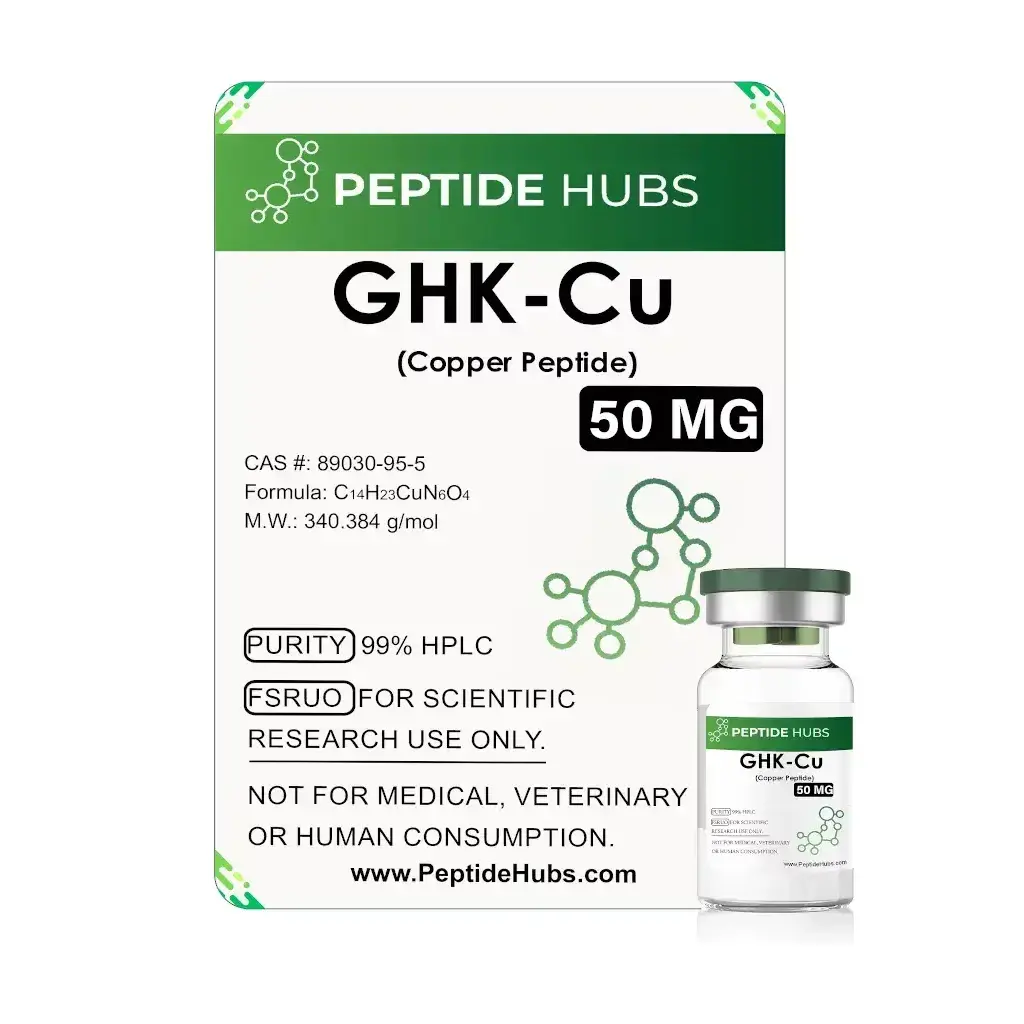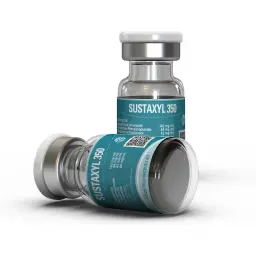



Drug Class: Copper-Binding Tripeptide
Composition: GHK-Cu (Gly-His-Lys)
Dosage: 50 mg/vial
Form: Lyophilized Powder
Unit: 2 mL Vial
Brand: Peptide Hubs
Laboratory Test: View Lab Report
For Research and Laboratory Use Only
For researchers dedicated to unlocking the secrets of tissue repair, collagen synthesis, and systemic rejuvenation, Peptide Hubs presents its premium GHK-Cu 50 mg. This copper-binding tripeptide (Gly-His-Lys) is a naturally occurring molecule in human plasma whose levels decline with age, making it a critical compound for anti-aging and regenerative research. Sourced and stocked within the USA, our GHK-Cu is provided as a highly pure, distinctive blue lyophilized powder in a sterile 2 mL vial, ready for precise research applications.
At Peptide Hubs, transparency is paramount. Our commitment to quality is verified by independent, third-party laboratory testing, confirming that every vial of GHK-Cu meets or exceeds its stated potency. When you buy GHK-Cu USA from us, you are investing in a research compound backed by data and delivered with speed and discretion from our US-based facility.
GHK-Cu is a naturally occurring tripeptide complexed with a copper ion. It was first discovered in human plasma, where its concentration is highest in youth and declines significantly with age. This peptide acts as a powerful signal transducer, influencing the expression of numerous genes related to tissue repair and regeneration. A comprehensive review in the National Institutes of Health Journal details its wide-ranging biological activities, stating that GHK-Cu "improves wound healing, skin remodeling, antioxidant and anti-inflammatory effects, and promotes hair follicle growth." Its ability to reprogram gene expression to a more youthful, healthy state makes it a cornerstone of modern regenerative research.
GHK-Cu's research significance lies in its multifaceted mechanism of action, functioning as a master switch for numerous repair processes:
The effects of GHK-Cu in research models are broad and profound, impacting both aesthetic and functional recovery. Key observed outcomes include:
Important: The following information is based on common research protocols and is provided for educational purposes. Researchers must consult scientific literature to determine appropriate dosages for their specific models.
GHK-Cu is typically administered via subcutaneous injection. Research dosages commonly range from 1 mg to 5 mg per day, with many protocols settling on 2-3 mg daily. For systemic effects, subcutaneous administration is preferred. For topical research in skin models, it can be reconstituted and applied directly.
Reconstitution: The lyophilized powder must be reconstituted with Bacteriostatic Water (Bac Water). Reconstituting a 50 mg vial with 2 mL of Bac Water yields a concentration of 25 mg/mL. A 0.1 mL injection would then deliver a 2.5 mg dose. The distinctive blue color is normal. Peptide Hubs offers pharmaceutical-grade Bac Water for optimal reconstitution.
Research cycles with GHK-Cu are typically medium to long-term, as its effects on collagen remodeling and gene expression are cumulative. Cycles often range from 8 to 16 weeks to observe significant tissue-level changes. Its versatile nature makes it an excellent candidate for powerful combination research.
Here are advanced research stacks involving Peptide Hubs GHK-Cu:
GHK-Cu is generally considered very safe with a high tolerance profile. However, researchers should be aware of the following potential observations:
Notably, GHK-Cu is non-hormonal, does not suppress the HPTA axis, and has no known androgenic, estrogenic, or liver-toxic effects.
Choosing to buy GHK-Cu USA from Peptide Hubs means selecting a research compound of exceptional purity and proven potency. The distinctive blue color and verified lab results are your assurance of a high-quality, authentic product. Our 50 mg vial is perfectly sized for extended research cycles, providing excellent value. With our direct US shipping and commitment to researcher satisfaction, Peptide Hubs is your trusted source for this revolutionary regenerative peptide.
Name: GHK-Cu
Drug Class: Copper-Binding Tripeptide
Other common names and terms: Copper Peptide, Glycyl-L-Histidyl-L-Lysine
Active Life: Several hours (induces long-term gene expression changes)
Detection Time: Not well-established
Chemical Structure: Gly-His-Lys complexed with Cu²⁺
Common Doses: 1 mg - 5 mg per day
Blood pressure: No significant effect reported
Acne: No effect reported; may improve skin quality
Water retention: No effect reported
Aromatisation: Does not aromatize
Liver toxicity: No liver toxicity reported; may be hepatoprotective
Decrease HPTA function: No suppression of the HPTA axis
The distinctive blue color of GHK-Cu is completely normal and is a direct result of the copper ion (Cu²⁺) binding to the Gly-His-Lys tripeptide. This complex, known as a coordination complex, absorbs light in the red part of the spectrum, making the powder appear blue. A strong, vibrant blue color is generally a good visual indicator of a properly synthesized and pure product, as it confirms the successful complexing of the copper to the peptide. Our third-party lab tests provide definitive proof of purity and dosage.
Yes, GHK-Cu is highly effective for topical application in research models focused on dermatology and skin health. When reconstituted and applied directly to the skin, it can improve skin firmness, reduce wrinkles, and enhance overall appearance by stimulating collagen production and antioxidant activity directly in the dermis. For systemic effects on connective tissues, joints, and for its gene-reprogramming benefits, subcutaneous injection is the preferred research route.
The localized itching or temporary discomfort is a very common and benign reaction to GHK-Cu. It is believed to be caused by the peptide's potent activation of local immune cells and the initiation of repair processes, including increased blood flow. This reaction typically subsides within an hour. To manage it, researchers can try: 1) Slowing the injection rate, 2) Applying a cold pack before and after injection, 3) Ensuring the solution is fully reconstituted and at room temperature, and 4) Rotating injection sites regularly.
GHK-Cu and BPC-157 are complementary but work through different mechanisms. BPC-157 is a rapid-response "emergency" healer, promoting angiogenesis and cell survival at the specific site of acute injury (e.g., a torn tendon). GHK-Cu is a "systemic remodeler" that works more slowly by reprogramming gene expression to enhance the quality and structure of the collagen matrix throughout the body. For comprehensive injury research, they are often stacked—BPC-157 for immediate repair and GHK-Cu for long-term tissue strength and quality.
In research focused on skin quality, initial improvements in skin hydration and texture may be observed within 2-4 weeks. However, significant changes related to collagen remodeling—such as increased firmness, reduction in deep wrinkles, and improved elasticity—are slower processes. Measurable improvements in these areas are typically documented after 8-12 weeks of consistent administration, as the natural collagen turnover cycle is approximately 3 months.
Please log in to write GHK-CU 50 mg review.

For Intramuscular Injection
Composition:
- Testosterone Propionate 42 mg
- Testosterone Phenylropionate 84 mg
- Testosterone Isocaproate 84 mg
- Testosterone Decanoate 140 mg
Mixed Dosage: 350 mg/1 mL
Unit: 10 mL Multidose Vial
Manufactured by Kalpa Pharmaceuticals